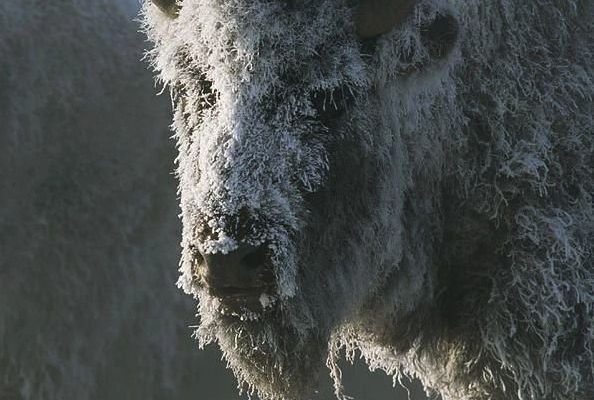
Imagine for a moment that you’re bundled up in a thick winter coat while facing a blizzard. Now, picture a bison, with its shaggy fur and massive frame, navigating the same snowstorm without a care in the world. That’s pretty impressive, right? Let’s dive deeper into the incredible strategies bison use to survive and thrive in tough conditions.
Physical Adaptations of Bison
One of the most striking features of bison is their massive size. Adult bison can weigh up to 2,000 pounds! This bulk is not just for show; it plays a crucial role in their survival. For instance, their body mass helps them conserve heat during harsh winters. While smaller animals might struggle to find warmth, bison can store energy and remain insulated thanks to their thick layers of fat and fur.
Speaking of fur, bison have a unique coat that changes with the seasons. In winter, their fur thickens, forming a dense layer that traps warm air close to their bodies. This insulation is vital since they often roam in temperatures that can plummet below freezing. As spring approaches, they shed this thick coat, making way for shorter hair that’s more suitable for the warmer months. Isn’t it fascinating how nature helps animals adapt?
Feeding Habits: Grazing Strategy
Bison are primarily grazers, munching on grasses, herbs, and even shrubs. Their diet is tailored to their environment, allowing them to thrive in the tall grasslands and plains they call home. One of the keys to their survival is their ability to find food even during tough times, like winter when vegetation is scarce.
You might wonder how they manage to eat when snow covers the ground. Bison are equipped with strong, muscular tongues that can strip leaves off branches and dig through snow to find grass underneath. This skill gives them an edge over other herbivores that may not have the same ability. By effectively utilizing their surroundings, bison can maintain their energy levels and withstand the rigors of their environment.
Social Structure and Herd Behavior
Bison are social animals that thrive in groups known as herds. This herd behavior is not just about companionship; it also enhances their chances of survival. Living in a herd offers protection from predators, like wolves or bears. When bison sense danger, they can band together, forming a protective circle around the weaker members, like calves.
Moreover, being in a herd helps bison maintain a social structure that allows them to communicate and gather information about their environment. They use various sounds and body language to alert one another about potential threats. It’s like having a built-in warning system, ensuring they stay safe in their natural habitats.
Water Sources and Hydration Strategies
Water is essential for all living beings, and bison are no exception. They need to drink regularly, especially during hot summers when hydration becomes critical. You might be surprised to know that bison can travel up to several miles to find water sources, whether it’s a river, pond, or even a puddle.
Interestingly, bison have a knack for sensing where to find water. They can detect subtle changes in their environment or follow other animals that may lead them to hydration sources. This ability is crucial, especially in harsh environments where water can be sparse. Their keen instincts help them thrive where others might fail.
Behavioral Adaptations to Extreme Weather
Bison have developed a range of behaviors that help them cope with extreme weather conditions. During harsh winters, they often use their powerful bodies to plow through deep snow, allowing them to access food hidden beneath it. When the temperatures drop, you may find them huddled together, conserving heat as a group.
When summer hits and temperatures rise, bison will find mud wallows to roll in. This not only helps them cool off but also acts as a natural sunscreen, protecting their skin from sunburn and insect bites. It’s a clever strategy that showcases their adaptability to changing environmental conditions.
The Role of Habitat and Migration
Bison are found primarily in grassland habitats, which provide ample food and space to roam. However, their habitats can change due to seasonal shifts or climatic changes. To find suitable food and water, bison often migrate, sometimes covering vast distances in search of better conditions.
Migration is ingrained in their behavior and is critical for their survival. These epic journeys allow them to adapt to seasonal changes and find the resources they need. As they move, they also play a vital role in maintaining the health of the grasslands by grazing and spreading seeds, contributing to the ecosystem as a whole.
Conservation Efforts and Challenges
While bison are remarkable survivors, they still face challenges today. Habitat loss and changes in land use have put pressure on their populations. Conservation efforts are underway to protect these majestic animals and their habitats. Organizations are working to restore bison to their native ranges, ensuring they can continue thriving.
Challenges remain as human activity encroaches on natural habitats. However, by raising awareness and supporting conservation efforts, we can help ensure that future generations have the chance to marvel at these incredible animals in the wild. Each step we take towards conservation is a step toward preserving a piece of natural history.
Bison are truly amazing creatures that have adapted to survive in some of the toughest environments on Earth. From their thick fur and massive size to their social behavior and impressive feeding habits, bison showcase nature’s brilliance in action. By understanding how they adapt, we can gain a greater appreciation for their role in the ecosystem and the importance of conserving their habitats.
It’s heartening to know that despite the challenges they face, bison continue to thrive in the wild. Their ability to survive in harsh conditions is a testament to their resilience and adaptability. So, the next time you think about survival in the animal kingdom, remember the bison—nature’s enduring champions.

